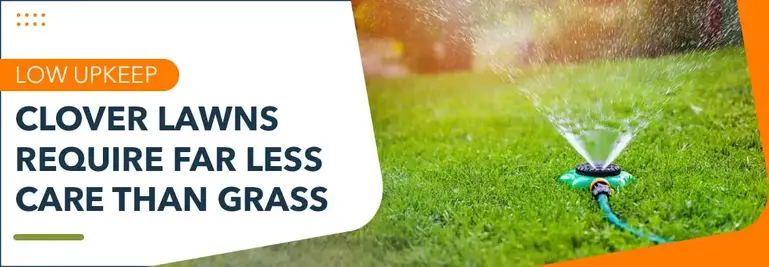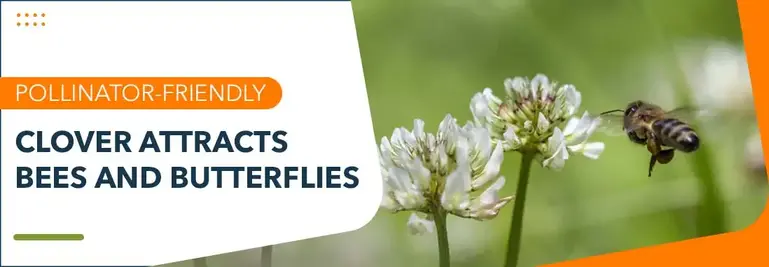Switching to a Clover Lawn?
205 Homeowners Share Their Thoughts

Less mowing, less watering, and no need to fertilize or aerate — clover lawns make sense for some. A clover lawn can be a great way to create a beautiful and eco-friendly lawn alternative. Bees love clover. An HOA might not, though. But if you're considering starting a clover lawn, you're not alone. We asked 205 homeowners to gauge how likely they are to make the switch.
Key Takeaways:
|
|
|
|
|
Survey Results

Very Likely: 42 votes (20.5 %)
Likely: 58 votes (28.3 %)
Neutral: 31 votes (15.1 %)
Unlikely: 52 votes (25.4 %)
Very Unlikely: 22 votes (10.7%)
While not a new option, clover lawns are becoming more talked about as a low-maintenance, weed-free, and pet-friendly alternative to traditional grass lawns.
As we spoke with homeowners, we dug deeper to learn more about the pros and cons they discussed when considering clover in their lawns.
First, let's look at what exactly a clover lawn is.
What is a Clover Lawn?
A clover lawn is typically mixed with traditional grasses to create a strong turf system. Clover is a low-growing, perennial plant with a unique ability to boost nitrogen in the soil, fertilizing the surrounding grasses.
For many homeowners, clover's benefits convinced them to add a good deal of it to their lawns.
Benefits of Clover Lawns
Clover lawns have many advantages over traditional, monoculture grass lawns. Traditional grass lawns must be regularly mowed and sprayed with pesticides to remain in top shape, but clover lawns are hearty and healthy. Clovers also have benefits for us and our pets. They are soft underfoot and don't grow as high as grass, making it easier for our pets to walk on.
Clover lawns eliminate the need for herbicides and pesticides. Keep in mind that clover lawns attract pollinators. A clover lawn isn't a good option if you don't want close interaction with bees.

Low Maintenance Requirements
One of the best things about a clover lawn is its low maintenance; it is hardy, drought-resistant, and requires much less water than most turf grasses. Established clover will grow fine with minimal watering, and it's perfect for those who want to reduce water use.
Natural Nitrogen Fixation
Clover is a legume, meaning it captures nitrogen from the air and deposits it in the soil via a symbiotic relationship with bacteria in its root system. Once it has established itself, it needs little sustenance — the clover largely feeds itself, and its deep root systems bolster surrounding grass without the need for any extra fertilizer. Pretty cool, right?
Clover can grow in various soil types, including soil with poor fertility or high acidity. Many grass species struggle to do this, and a ground cover that can establish and spread in less-than-ideal soil conditions can be much more reliable than grass when areas become degraded.
What is the difference between grass and clover?

If you are thinking about switching to a lawn of white clover, the best way to characterize it is by comparing it to a traditional grass lawn and highlighting the differences.Clover lawns are more environmentally friendly: less fertilizer and less frequent watering reduce resource usage and lower the carbon footprint of lawn maintenance. Their flowers attract pollinators like bees and butterflies, which are good for local biodiversity.
What sets the clover lawn apart from grass is its density compared to traditional grasses. The leaflets feel soft on the soles of your feet, and they cover the ground in a green carpet, held in place by its stolons (underground stems) and rhizomes (underground roots). The little white or pinkish flowers pop up in spring and early summer.
Grass lawns need to be mowed, fertilized, and watered on an ongoing basis to stay green and healthy, whereas clover lawns need to be mowed only a few times a year to keep them looking neat.
Its ability to naturally fix nitrogen means that there is no need to add fertilizer, and its drought resistance means that it needs minimal watering.
Clover often stays green and lush with little watering when the grass goes brown and dormant during dry periods. It's an ideal species for homeowners who care about water conservation.
Most grass lawns require regular chemical fertilizers to stay green; they can contribute to water-borne pollution and damage local ecosystems. Clover varieties are also less susceptible to insects and diseases than traditional grasses.
But not everything is peachy for clovers. Grass can tolerate heavy foot traffic better than clover. Clover is pretty hardy but not as sturdy as some grass varieties, especially when it is subject to regular pounding. This is something to think about for families with kids or pets who want to play on the grass before switching to a clover lawn.
Cons of Clover Lawns
It’s important to consider the drawbacks of moving to clover — many of which are why some survey takers said they would be unlikely to switch to a clover lawn.
First, several said they would not move to a clover lawn since it cannot handle high traffic.
One respondent wrote
"We're always out in our yard. Our kids just do too much out there for us to consider moving over to a clover lawn."
In addition to being unable to handle high traffic, clover can spread quite quickly — potentially encroaching on garden beds or other areas. Your lawn might also look off if your clover stays green and lush while your grass browns and dies.
Types of Clover

White Clover (Trifolium repens)
White clover is the most common and preferred variety of clover for lawns. It grows low to the ground, with small white flowers and runners that help it spread and form a matting, green carpet. White clover is hardy, drought-tolerant, adaptable to many soil types, and can grow in full sun or partial shade.
Micro-Clover
Micro-clover is a lower-growing white clover type that is increasingly used for lawns. It has all the benefits of white clover, but, as the name suggests, it is much lower growing, which means that, along with being less full, it's better suited to those who want a more formal lawn appearance.
Red Clover (Trifolium pratense)
Red clover is another good choice for ground cover but isn't as widely used in lawns as white clover. It grows noticeably taller than white clover, and the leaves are narrower and lighter in color. The flowers are also pinkish-red.
Frequently Asked Questions About Clover Lawns
What are the benefits of a clover lawn?
Clover lawns have several advantages: low maintenance, natural fertilization, drought resistance, environmental friendliness, support pollinators, and green and lush appearance with minimal input.
Can clover lawns withstand heavy foot traffic?
Clover is not as drought- or wear-tolerant as some grasses, particularly if you get a lot of heavy foot traffic. It works best in lawns with light or moderate use or mixed with grass to help it hold up.
How do I start planting clover in my lawn?
To plant clover, after removing the grass or weeds in the soil, you should scatter the clover seed evenly and water gently until it is established.
Is clover good for the environment?
Yes, clover is eco-friendly because it reduces the need for chemical fertilizer and pesticides, saves water, attracts pollinators, improves soil health, and reduces erosion.
What type of clover is best for lawns?
Due to its low-growth habit and toughness, white clover (Trifolium repens) is probably the most widely recommended and commonly found species in lawn mixes. Micro-clover, a smaller type of white clover, is also commonly recommended and widely used in lawn mixes because of its compact growth habit.
How often should I mow a clover lawn?
Clover lawns need much less mowing than grass lawns. In most climates and conditions, you'll probably only need to mow three or four times a year to keep clover lawns tidy. Keep your mower blade on the high side for clover, with a setting of 3 to 4 inches. If you try to cut the clover too short, it will become stressed.
Quick Summary
Category |
Details |
Survey Results |
Likelihood of Switching to Clover Lawns |
Very Likely |
20.5% |
Likely |
28.3% |
Neutral |
15.1% |
Unlikely |
25.4% |
Very Unlikely |
10.7% |
Pros |
Cons |
Low Maintenance |
Cannot Handle Heavy Foot Traffic |
Drought-Resistant |
May Spread into Gardens |
Natural Nitrogen Fixation |
May Appear Uneven When Grass Browns |
Eco-Friendly |
Less Durable than Grass |
Supports Pollinators |
Requires Careful Planning |
We surveyed 205 homeowners to find out how likely they were to transition to a clover lawn. We also looked at the pros and cons of a clover lawn. Clover's low-maintenance, drought-tolerant, environmentally friendly, and nitrogen-rich properties help it appeal to many.
For several respondents, clover's inability to handle foot traffic well and its propensity to spread into areas like gardens kept them from considering moving to add clover to their lawns.






 Share
Share











